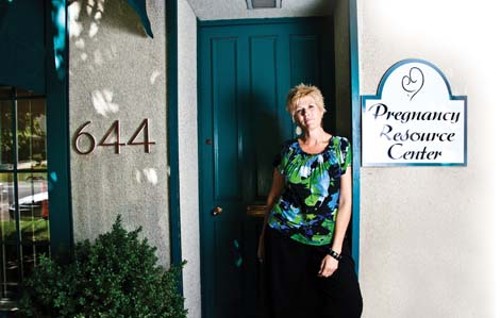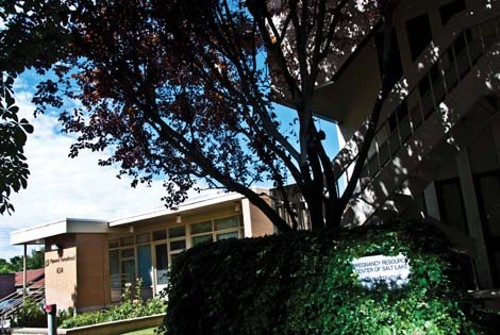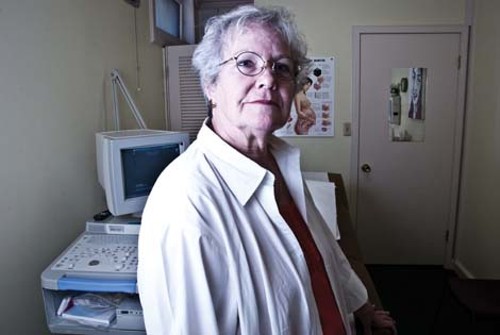Pregnant Pause at the Pregnancy Resource Center
The Pregnancy Resource Center wants Utah women to stop and think before they abort.
By Stephen Dark @stephenpdarkJackie, who withheld her last name, was alone and scared. “What was I supposed to do?” she says bitterly. “I mean, really?”
At the Utah Women’s Clinic, one of three abortion providers in Utah, she lay on the operating table awaiting an abortion, but started hyperventilating and tore the oxygen mask off.
The doctor asked if she wanted to stop the procedure, but Jackie felt she had no choice. She remembers hearing the suction machine being turned on to extract the fetus’ remains. The doctor left and Jackie, half-naked, fell off the table to the floor and curled up in tears. “At that very second, I wanted to take back what I had done.”
Plagued for years by post-abortion despair and self-destructive behavior, Jackie last year heard Tamara Anderson speak about the nonprofit Pregnancy Resource Center (PRC) at a Sunday service of the nondenominational Calvary Chapel Salt Lake, off of Interstate 15's 4500 South exit. Anderson, PRC’s executive director, a woman who always seems on the edge of tipping over into a hug, spoke of offering pregnant women other options besides abortion, which, according to the PRC’s Website, “only compounds human need rather than resolving it.”
Rather than offering women the means to terminate a pregnancy, the nonprofit gives a free, self-administered pregnancy urine test—which Anderson acknowledges can be unreliable—counseling, an ultrasound to verify pregnancy, clothing and food for the baby up to one year after birth as well as post-abortion support. Jackie volunteered and one year later, credits the PRC, and particularly its Post Abortive Counseling Education (PACE), with saving her life.
For its pro-choice critics, though, the PRC’s location—next door to family-planning and birth-control clinic Planned Parenthood (PP) on a quiet, tree-lined stretch of 900 East between 600 and 700 South in downtown Salt Lake City—underscores its methods to pursue a pro-life agenda. PP’s executive director Karrie Galloway says there’s a national pattern of Pregnancy Resource Centers moving close to Planned Parenthood clinics. Such PRCs can take advantage of the “confusion factor” of young women who go to the wrong door or enter seeking help without recognizing the political agenda behind the help being offered.
The high-pressure pro-life tactics employed in other states—emotional lectures, aggressive picketing, even firebombing abortion clinics and killing abortion providers—are not evident in what Galloway calls “polite” Utah. But she expresses concern about misleading information in pro-life brochures disseminated by the Salt Lake City PRC and its use of ultrasound machinery purchased by the PRC in 2008 through a grant from Focus on the Family. Under President George W. Bush, Galloway says, “There were many moves to initiate parity funding for anti-choice reproductive health care, so they could make their case for women not to choose abortions,” one of which was to provide PRCs with ultrasounds.
The ultrasound has proven to be an effective tool. Anderson wrote in the PRC’s March 2010 newsletter that supporters “believed that if women were able to see their unborn babies they would begin to love them,” noting that 87 percent of PRC clients who had the ultrasound decided against abortion. While PP’s Galloway says such uses of an ultrasound amounts to emotional blackmail, others are more receptive to the PRC’s pitch. PRC nursing manager Joan Manning spoke at a January 2010 Utah Senate committee hearing in support of House Bill 200, which made it mandatory for ultrasounds to be offered to abortion-seeking women. Anderson wrote in her newsletter that Manning brought “light to the perils of abortion and the woman’s need to see her ultrasound.” The bill was passed later in the session.
Unlike Jackie’s traumatic experience, some other women view abortion as simply a five-minute procedure followed by a period of physical discomfort. Teresa, who works in retail, had her first abortion when she was 18. Two years later, one Tuesday afternoon in late July in the Utah Women’s Clinic, she has returned for her second. While some might think her selfish, she says, “they’re not the ones who have to raise [the baby].” She takes an analgesic for the coming pain—“It’s like cramps,” she says of the procedure—and indicates that the amount of fetal material from the seven-week pregnancy is little more than a pea. “It’s no big deal,” she says.
With Planned Parenthood’s Metro Clinic (downtown Salt Lake City) set to offer abortions in a few weeks and the PRC, according to board member Steve Earnshaw, wanting “a louder microphone,” the fight for the minds and souls of young women like Teresa might well begin to heat up. For now, though, the PRC’s mostly women volunteers, many with personal scars from long-regretted abortions, clearly recognize that their most effective tool in this grass-roots fight for the hearts and minds of often low-income, scared, single women is one that pro-choice supporters don’t mention: namely the PRC’s arsenal of hugs, smiles and attentive ears.
With God On Our Side
Anderson’s message is clear: The PRC is a compassionate organization that cares for both women and their fetuses. It is dedicated to providing women with alternatives to abortion, it helps heal the emotional wounds of post-abortive women through counseling and Bible study and it promotes a biblical view of sexuality, notably abstinence until marriage. While according to Utah Department of Health statistics, around 3,500 abortions are performed in Utah a year, the PRC claimed 35 babies were born by 2009 clients in the first quarter of 2010.
Anderson walks a tricky line between the dramatic language of faith she employs when communicating with Christian supporters across the Salt Lake Valley and the emotional needs of the 19- to 25-year-old women she is trying to reach. PRC supporters are urged to pray “for abortion-minded women to feel our compassion and keep their appointments” and thanked for giving their coins to a campaign “to help change the minds and hearts of women who thought abortion was their only solution.” For the young women the PRC is targeting, its language is religion-free. “Pregnant? Scared?” read a recent PRC billboard. “We are here for you.”
On Aug. 2, HBO premiered a documentary called 12th and Delaware, about a crisis-pregnancy center—the pro-choice movement’s preferred term for pregnancy-resource centers—which opened opposite an 8-year-old abortion clinic in a Florida town. When Galloway saw the film at the 2010 Sundance film festival with American Civil Liberties Union lawyers and local abortion providers, she found it “a very disturbing experience.” She says she experienced “such angst, realizing what women were being put through in the [Florida-based] PRC, browbeaten over their decision not to terminate the pregnancy.”
Watch an interview with the filmmakers of 12th and Delaware:
When Anderson watched the film, she said she did not agree with the Florida PRC director’s confrontational style. “Different people love differently,” she says. “That wouldn’t be the way I would do it.”
Contrary to the criticism of intimidation and coercion that pro-choice critics level at PRCs, she says her PRC does not browbeat clients. “I want it to be honest, truthful, caring, respectful of clients and their needs. We understand women have a choice to make. You can’t make choices for people.”
Welcome To The Neighborhood
The Pregnancy Resource Center, which opened in 1986 in a downtown church basement, has a staff of four paid employees and 40 volunteers, all funded by a $200,000 budget, financed in large part, according to Anderson, by individual donors.
Its nonprofit tax returns for 2007 show public support of $154,123, the PRC raising just under $100,000 that year from its annual banquet and a baby-bottle campaign, where sympathetic churches, ranging from Lutheran and Baptist to nondenominational Christian churches, had their members fill bottles with change. An additional financial source is a federal grant for teen abstinence training, which in 2009 was $45,000.
Three years ago, the PRC paid former PACE volunteer counselor Jolene Earl and her husband, Glen, $800,000 for their residence/acupuncture studio next door to Planned Parenthood. Former PRC board member Sherrie Craig thought the location was perfect. “[Planned Parenthood] are pro-choice, we are pro-life, why not? It’s not like we are ashamed or anything. Why not have a place next door to give more information?” She adds that “it blows my mind” that other PRCs across the country have deliberately sought to place themselves next door or very close to reproductive-health centers. “We thought we were original.”
Galloway first learned about the PRC moving in when she got a call while on vacation. “Guess who we have as new neighbors?” a PP colleague asked her. On occasion, she says, groups opposed to birth-control pills come from next door and put out lawn chairs in front of PP, play music and erect posters—something Anderson vehemently denies. But Galloway isn’t opposed to the PRC. “For many women, abortion is not the answer to unintended pregnancy,” she says.
Where Galloway’s hackles rise is the use of what she calls “inaccurate information” to pursue a pro-life agenda, particularly with regard to “the safety net” of emergency contraception—the morning-after pill—that PRC literature characterizes as an “early abortion.” PRC’s Manning says if you believe that life begins when sperm meets egg, then an abortion is exactly what the emergency contraceptive provides.
Other contentious debates that have the two camps refusing to budge include the long-disputed possible link between abortion and breast cancer—which NARAL Pro-Choice America’s communication director Ted Miller says was debunked by credible scientific evidence long ago; the effectiveness of condoms; whether abortion can cause long-term psychological damage; and at what gestational age a fetus feels pain.
Galloway also chafes at the PRC not promoting “healthy, safe sex.” If the PRC promoted safe and healthy sexual relations and family planning rather than abstinence, she argues, then “that would cut down on the need for abortions.” Every dollar that is spent on family planning “saves $4 in social services and health care.”
Care On Delivery
A first-time PRC client fills out a form, which seeks information on both religious orientation and whether an abortion is sought. Whether the urine test is positive or not, the client is offered counseling by client advocates “who share God’s truth with love and grace,” according to the Website. The advocates have often gone through teen pregnancies as single mothers.
Counselors show clients interested in fetal development the startling contents of a small, black-felt-covered box—namely four pink fetuses marking the stages of the first trimester. For information on abortions, board member Steve Earnshaw says brochures such as “Before you decide” are a blessing, since “they do much of the heavy lifting.” The brochures are produced by Care Net—which the Salt Lake City PRC is affiliated with—one of three national pro-life umbrella organizations for pregnancy resource centers.
Along with a detailed description of medical and surgical abortions, the booklet also focuses on the spiritual consequences of abortion. Having an abortion, it says, “may have an impact on your relationship with God. What is God’s desire for you in this situation? How does God see your unborn child?”
Clients are offered a free ultrasound between six and 12 weeks into their pregnancy. The ultrasound, PRC nursing manager Joan Manning says, “allows [clients] to know there is life, that a baby is growing inside them.” The fetus is measured from “crown to rump” and the mother given her due date. Then, Manning puts a series of images of fluttering heartbeats on replay so the mother can have time alone contemplating her pregnancy. “They begin to bond with the baby,” the grandmotherly Manning enthuses. Then, with her unwavering brown eyes, she puts the client on the spot. “Often they’ve scooted around the issue,” she says. “We acknowledge [the decision] is hers to make and ask what she’s planning on doing.”
Manning gives the pregnant client a blanket and booties and asks what words to type on the ultrasound image the client takes away as a memento. “Sometimes they want ‘awesome,’ sometimes ‘Hi, mommy,’ ” Anderson says. Neither the client’s name nor the fetus’ gestational age are put on the image to ensure it is not used to facilitate an abortion.
Finally, Manning will ask to pray with the client, to thank God for bringing her to the PRC, for providing “the miracle of the ultrasound” and to guide her steps for “the life growing inside her.”
A few blocks away, at the Utah Women’s Clinic, abortion provider Dr. Madhuri Shaw and her office manager, Miriam Staker, offer a different perspective on ultrasounds. Staker says ultrasounds bring closure for women with fetuses at six weeks’ gestation when they see the empty sack and yolk. But when the fetus is more developed, Shaw, who has performed 70,000 to 80,000 abortions in her 40-year career in Utah, says the impact of seeing an ultrasound on a young woman “can be a destructive, painful thing.”
That’s apparent in the words of a 27-year-old woman—who asked that her name be withheld—minutes after she underwent a surgical abortion at the Utah Women’s Clinic. She sits wrapped in a blanket on a stretcher in one of the examination rooms, swaying and occasionally crying from the pain. She wanted to see the ultrasound of her unplanned 11-week fetus. “I saw a head and body.” She was startled. “My mind went blank. I took a deep breath. I couldn’t think for 30 seconds.”
How the doctor treated her in the operating room also created problems. An abortion, she says, is such an invasive, personal thing, yet the doctor came in and set to work without a word. She had to ask his name. “I thought that was a little traumatizing.” That said, in such a conservative state as Utah, she says, “it’s great that people have the resource and choice.”
The Dead Zone
They had two children together, but then John “made some stupid mistakes” and went to jail. At the same time, Crystal realized she might be pregnant. After a home-test kit she bought at a dollar store confirmed her suspicions, she went to Planned Parenthood “hoping to find answers” to her questions about abortion. They told her they don’t perform abortions, gave her a list of places that would, and, she says, “sent me away with a wave of their hand.”
She walked by the PRC and, on impulse, went inside. When they said they could only tell her about abortions—and not provide a referral to a provider—she started to leave in tears, only for several PRC volunteers to hug her and persuade her to stay.
A counselor explained “in graphic detail” what happened to a fetus during an abortion. “The woman has reeds placed inside her,” she recalls being told. “You either have the baby suctioned out or pulled out in pieces. Further along, you have to take a funky knife and cut it in pieces and suction it out.” Crystal was crying during the counseling, “trying to put myself in a place where I felt nothing.”
For four hours, PRC staff and volunteers talked and listened to her, she says. A counselor offered her a Bible and said a prayer for her. “It was a nice prayer about staying strong,” Crystal says.
Upset that she wasn’t able to get an abortion, she went home, “still in denial I was pregnant, keeping it to myself.” She went back to the PRC two weeks later for an ultrasound with John, who was now out of jail. When the nurse pointed out the fetus on the screen, John, Crystal says, “had butterflies and was smiling.” Crystal didn’t share his joy. “I wanted to feel good about it. It’s not fair. My heart wasn’t in it.”
The PRC gave her papers with a June due date. Crystal went home, haunted by one piece of information that, she says, the PRC had given her: The fetus can feel pain after 10 weeks, although Anderson cautions it’s only a possibility.
Crystal went back and forth over it, struggling for 20 weeks, until finally she gave up. “I couldn’t think about it anymore.” When it came down to it, she says, “I couldn’t do the abortion because I felt terrible, I couldn’t kill the baby.” She delivered and kept her baby.
A Booties Memorial
The PRC isn’t only about changing minds and hearts. It’s also concerned with the emotional wounds of post-abortive women. Some women, such as the 27-year-old in the Utah Women’s Clinic recovering from her abortion, regard the wounds that the PRC struggles to heal as simply part of her life. “It’s always at the back of my mind if I see a baby, a child,” she admits. But, she’s too busy with her career. While she might feel like crying or being sad, “you still have to move on.”
Women who wish to volunteer at the PRC and have had an abortion have to go through PACE, the 11-week Bible-study course. Currently, two middle-age women, Sue and Laurie, facilitate the course for typically six post-abortive women in a cozy living room, with plush carpet and sofas, at the back of the PRC.
When Sue learned the PRC was looking for post-abortive, Christian women to volunteer as facilitators, she thought, “for God to be any clearer, he would have to be right in front of me.” While she thought she had come to terms with the three abortions she’d had in the early stages of her marriage—“completely about my own convenience and economic situation”—she realized when she went through the training that was not the case. Finally, she says, “I was able to admit I killed my babies. My biggest regret was I denied them a life.”
One client, Sue recalls, had an abortion because her youngest child required constant attention. The abortion, Sue says, affected her marriage, her relationship with her oldest child and friends. “She and her husband ended up blaming each other. They both knew it was not God-pleasing,” Sue says. “The Bible is clear. Life is precious to God.”
After Jackie heard PRC’s Anderson speak at Calvary Chapel, she wanted to volunteer at the PRC but first had to complete the PACE course. “I wanted to give women like I was other options, but I didn’t want to deal with [my abortion].”
In the first session, four women shared their abortion stories. Jackie shared part of hers before the end, but afterward felt worse than ever. “The pain was at the surface, right in my face.”
The second week, she watched a video of a mother reading letters to a child she had aborted. Jackie says she asked God to apologize on her behalf to her child. God, she says, replied, “Why don’t you tell her yourself?” After the fifth session, on forgiveness, she sat in her car, furious, repeatedly going over her abortion trauma. Again, she says, God spoke to her. “He said, ‘You’re not the victim in this.’ That made me stop and think. The life that I took was the real victim.” Her anger, shame and guilt, she says, melted away.
At the end of the course, the women hold a memorial service and release balloons with messages for the children they never had. Jackie wrote her child a letter, read her a picture book and bought her a pair of booties, which sit in a glass case with dozens of other booties in the PRC living room.
Mama’s Boy
In the basement of the PRC is the Clothesline, which provides free clothing and toys for babies up to 1 year old, for those in need. “But, what happens after [that first year]? That’s the thing,” says Utah Women’s Clinic’s Staker. What are mothers who couldn’t afford to have the baby in the first place supposed to do then? Anderson responds that she refers mothers in need to state and nonprofit social programs that provide support.
Staker’s question is one that led 25-year-old Karen to have an abortion, something she thought she’d never have. She sits in a chair in the Utah Women’s Clinic, her knees drawn up to her, her face betraying both physical pain and emotional tension. “I’m a very spiritual person,” she says, in love with the man of her dreams. But the moment she realized she was pregnant, “alarms were going off” inside her head.
She and her partner live in “a tiny little condo, we have no car, no insurance, everything is against us.” She tried to “go with the flow,” have faith it would work out, but just the thought of a child was so stressful. “We can barely afford food at the end of the week.”
When she accepted abortion as an option, “I had my first moment of serenity, of peace.” Now, in the immediate aftermath of the abortion, at least, she says, she and her partner can prepare themselves to have and raise the baby they both want someday.
If Anderson’s young-adult daughter were pregnant, “I would not want her to have an abortion,” she says. “I’ve seen the heartache.” She acknowledges there are “tough situations,” like incest or rape, although in three years, she says she’s never seen an incest case and only one involving date rape. “What I’ve seen is women who made a choice to participate sexually and they become pregnant.”
Staker, however, estimates that during the past three years, she’s dealt with several pregnant minors every month. One such 13-year-old minor and her single mother are waiting in the Utah Women’s Clinic for a post-abortion ultrasound. The girl’s expression is stoic, the mother, a deer in the headlights.
The mother took her daughter to Planned Parenthood after she admitted she was sexually active. The girl says, “I was not really surprised [about being pregnant], it can happen.” She starts to cry when she acknowledges her mother won’t let her see her boyfriend any more. Girls her age “should wait,” she says, to have sex.
PP’s Staker knows the complexity of the abortion issue better than most. A practicing Catholic, she walks the line between the anti-abortion dictates of her faith and the needs of the many young women who come to her clinic. “We’re doing something good to help women,” she says, “trying to get them the best information to make their decision,” a belief Anderson shares, even if they disagree on what constitutes “best information.”
For women like Crystal who find themselves caught between choosing Planned Parenthood or the PRC, whichever door they take can, it seems, lead some to taxing emotional terrain. But the end result can also bring relief and, in Crystal’s case, joy.
“I don’t regret having [the baby] at all,” she says. After the doctor cut the cord and brought the child to Crystal’s waiting arms, placing him inside the hospital gown against her skin, she says, “I was just happy he was born healthy and glad he was in my life.”
More by Stephen Dark
-
Call it a Comeback
Long mired in economic depression, Midvale’s Main Street dusts off its small-town charm.
- Sep 20, 2017
-
Love Letters
Correspondence between a young woman at the Topaz internment camp and her beloved sheds light on Trump's America.
- Sep 6, 2017
-
Triggered
Veterans Affairs exists to help vets. So why did the Salt Lake VA appoint an anti-veteran chief?
- Aug 30, 2017
- More »
Latest in Cover Story
Readers also liked…
-
Forget the family pedigree—Robert F. Kennedy Jr should not be the next president of the United States
Trojan Horse
- Jun 21, 2023
-
Women decry harassment and toxic culture at St. George auto dealership
Men at Work
- Oct 11, 2023









